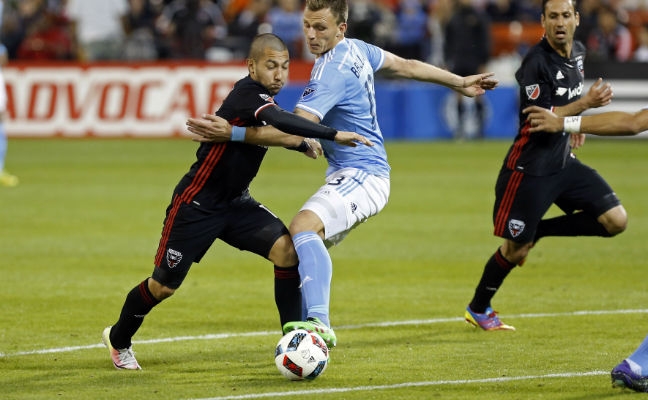Play of the Week 10: Free-kicks on the edge of the penalty area

By PRO Training & Development Manager Paul Rejer
Play of the Week 10 of the 2016 series discusses free-kicks awarded on the edge of the penalty area and deciding whether the foul took place in or out of the area.
This, of course, is a crucial call that match officials have to make as it means the difference between a goal scoring opportunity and an almost certain goal.
This week’s play is from the D.C. United versus New York City game, when United’s Luciano Acosta is unfairly charged by City’s Frederic Brillant on the edge of the penalty area. We have often discussed in previous Play of the Weeks the importance of referees being in the optimum position when making crucial calls, and when they occur on the edge of the penalty area it is vital when making that ‘in or out’ decision.
Referee Allen Chapman anticipates play well and is in good proximity with a clear view of the foul and the front line of the penalty area. AR Daniel Belleau is slightly ahead of the line, highlighting the fact that referees have license to position themselves anywhere on the field, whereas an AR’s position is prescriptive, level with the second last defender or the ball, whichever is nearer to the goal line. However, Belleau also has a clear view of the foul and the line, and is in a credible position to offer advice to the referee if he needs it.
Chapman sees, recognizes and acts by awarding the free-kick outside the penalty area. You will see the confident and convincing manner in which he makes the award – another important aspect to decision-making, which helps to ‘sell’ the call to players.
Chapman then decides to caution the offender, Brillant. Please observe the manner in which he administers the yellow card. It is issued in a calm and business-like manner, affording the player his dignity. It is not confrontational as we often see.
The setting up of the set piece is textbook. He paces out the correct 10 yards distance and draws the spray. He then warns the defenders in the wall not to raise their arms or they risk the chance of a PK being awarded against them. He then returns to the wall when he sees that some forwards may be in an offside position, and warns them that they are in danger of being penalized for offside should they remain there. This is excellent proactive management as there are no surprises when Belleau correctly signals Alvaro Saborio offside.
In summary, when we look at the foul we can see that Chapman is correct as the foul occurs outside the area. There will be an argument that contact continues inside the area. However, there is only one penal offense that can continue inside the penalty area and that is holding. This is because the holding still has an impact on the offended player inside the area, whereas all the other offenses can only happen in or out – kicks, trips, jumps, charges, strikes, pushes, tackles, spits, handles.
This was close and in real time it looks inside. These decisions are usually difficult for referees to judge. The forward will more or less always fall inside the area, but I have often said before that in the vast majority of cases the contact happens outside the penalty area as defenders are less likely to take a chance inside, knowing the consequences of conceding a PK.
There is so much excellent practice for any aspiring referee, who wishes to progress to the highest level, to learn from here:
– Positioning
– Seeing the offense
– Recognizing the offense
– Penalizing the offense
– Selling the decision
– Sanctioning process
– Free-kick management
– Edge of penalty area decision considerations
Not only excellent at all levels – it was Brill(i)ant!
